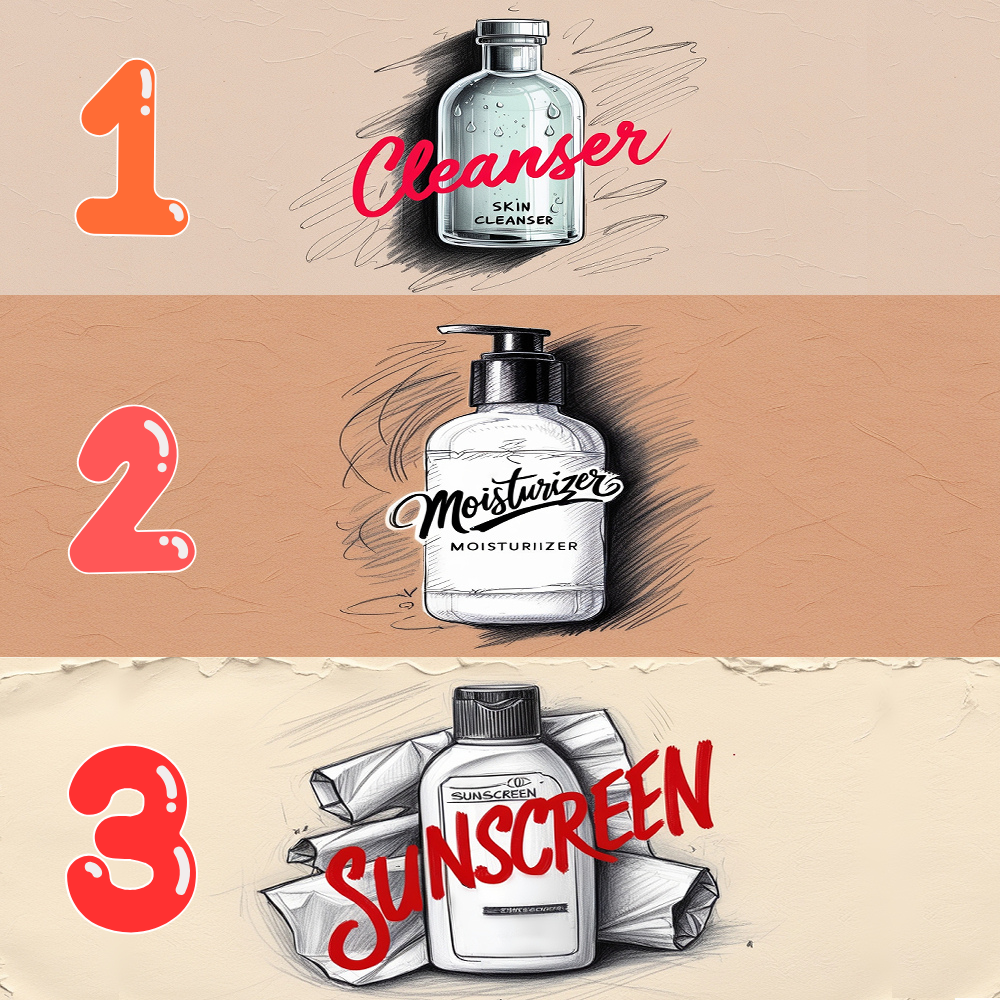How to Build a Basic Skincare Routine
Starting a skincare routine can seem overwhelming with all the products and ingredients available, but building a basic routine doesn’t have to be complicated. A well-designed skincare routine focuses on protecting, hydrating, and nourishing the skin, setting a foundation for healthier, happier skin.
Step 1: Identify Your Skin Type
Before jumping into products, understanding your skin type is crucial for choosing the right ones. Skin types generally fall into five categories:
Normal: Balanced, with no significant dryness or oiliness.
Oily: Produces excess oil, often leading to shine, especially on the T-zone (forehead, nose, and chin).
Dry: Lacks moisture and can feel tight, with a tendency to flake.
Combination: A mix of oily and dry areas, typically with an oily T-zone and drier cheeks.
Sensitive: Easily irritated, prone to redness, and may react to various products or environmental factors.
Knowing your skin type helps you choose products that will work harmoniously with your skin, preventing irritation and promoting balance.
Step 2: The Basic Building Blocks of Skincare
A good skincare routine doesn’t have to be complex. In fact, there are only three essential steps: cleansing, moisturizing, and sun protection
1. Cleanser: Cleanse Gently, Morning and Night
Cleansing removes dirt, oil, makeup, and pollutants that build up on your skin throughout the day. A gentle cleanser is best to avoid stripping the skin of its natural oils. Look for:
Foaming Cleansers for oily or acne-prone skin, as these can help remove excess oil.
Gel Cleansers for combination skin, as they cleanse without over-drying.
Cream or Milky Cleansers for dry and sensitive skin, as they are moisturizing and won’t disrupt the skin barrier.
How to Use: Gently massage a dime-sized amount onto damp skin and rinse with lukewarm water. Avoid using hot water, as it can be drying and irritating.
2. Moisturizer: Hydrate and Protect Your Skin Barrier
Moisturizing helps to lock in hydration and maintain the skin’s protective barrier. Choose a moisturizer that suits your skin type:
Lightweight Gels or Lotions for oily or acne-prone skin. These are less likely to clog pores and feel light on the skin.
Creams for dry and combination skin, as they provide deeper hydration.
Fragrance-free or Hypoallergenic Moisturizers for sensitive skin to avoid irritation.
How to Use: Apply a small amount after cleansing, and gently massage it into your skin. If your skin feels dry or tight, add a bit more.
3. Sunscreen: The Most Essential Step in the Morning
Sunscreen is the most important step for protecting your skin against premature aging, sun damage, and skin cancer. Even if it’s cloudy, sunscreen is necessary, as UV rays can penetrate clouds and windows. Aim for a broad-spectrum SPF 30 or higher.
Mineral Sunscreens (zinc oxide, titanium dioxide) are ideal for sensitive skin and provide immediate protection.
Chemical Sunscreens are often more lightweight and are easily absorbed, making them suitable for normal and oily skin types.
How to Use: Apply a generous amount (around a nickel-sized amount for the face) to all exposed areas at least 15 minutes before going outside. Reapply every two hours if you’re spending extended time outdoors, especially if you’re sweating or swimming.
Step 3: Optional Products for Additional Benefits
If you want to address specific skin concerns, consider adding these steps:
Toner: Toners balance the skin’s pH after cleansing and prep it for moisturizers or serums. Hydrating toners (with ingredients like glycerin or hyaluronic acid) can be beneficial for dry skin, while toners with salicylic acid are suitable for oily skin.
Serum: Serums are concentrated formulas targeting issues like dryness, dullness, or fine lines. Look for serums with vitamin C for brightening, hyaluronic acid for hydration, or niacinamide for calming redness.
Exfoliant: Exfoliants remove dead skin cells, helping your skin appear smoother and more radiant. AHAs (like glycolic acid) are great for dry skin, while BHAs (like salicylic acid) work well for oily and acne-prone skin. Exfoliate 1-3 times a week, depending on your skin’s tolerance.
Eye Cream: Eye creams provide hydration and target issues like puffiness or fine lines around the eyes. If you have dryness or dark circles, consider adding an eye cream with ingredients like caffeine (for puffiness) or peptides (for firmness).
Step 4: Create a Routine That Works for You
Morning Routine:
Cleanser: Start with a gentle cleanser to remove overnight oils.
Moisturizer: Hydrate your skin with a moisturizer suited to your skin type.
Sunscreen: Apply SPF to protect your skin for the day.
Evening Routine:
Cleanser: Remove makeup, sunscreen, and impurities with your cleanser.
Moisturizer: Apply a moisturizer to lock in hydration while you sleep.
Optional steps (like a serum or exfoliant) can be added based on your goals but aren’t necessary for a basic routine.
Tips for Building and Sticking to Your Routine
Introduce New Products Slowly: When adding new products, especially active ingredients (like acids or retinoids), introduce them one at a time. This helps you monitor how your skin reacts.
Patch Test: To avoid irritation, test new products on a small area (like behind your ear or on your wrist) before applying them to your face.
Stay Consistent: Consistency is key to seeing results. Stick to your routine every day, even if you don’t see immediate changes. Most skincare products take several weeks to show noticeable effects.
Adjust for Season Changes: Skin can change with the seasons, so adjust your routine if needed. For example, switch to a richer moisturizer in winter and a lighter one in summer if your skin gets oilier in warmer months.


